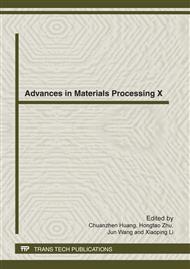[1]
Azad-Noorani, M., Jooybari-Bakhshi, M., Hosseinipour, S.J. and Gorji, A. (2005), Experimental & merical study of optimal die profile in cold forward rod extrusion of Al, journal of Materials Processing Technology, Vol. 164-165, pp.1572-1577.
DOI: 10.1016/j.jmatprotec.2005.02.019
Google Scholar
[2]
Knoerr, M., Lee, J. and Altan, T. (1992), Application of the 2D finite element method to simulation of various forming processes, journal of Materials Processing Technology, Vol. 33 (1-2), pp.31-55.
DOI: 10.1016/0924-0136(92)90310-o
Google Scholar
[3]
Kim, H., Sweeney, K. and Altan, T. (1994), Application of computer aided simulation to investigate metal flow in selected forging operations, journal of Materials Processing Technology. Vol. 46 (1-2), pp.127-154.
DOI: 10.1016/0924-0136(94)90107-4
Google Scholar
[4]
Kang, B. -Soo, Min-Kim, B. and Choi, J.C. (1994), Perform design in extrusion by the FEM and its experimental confirmation, journal of Materials Processing Technology, Vol. 41 (2), pp.237-248.
DOI: 10.1016/0924-0136(94)90064-7
Google Scholar
[5]
Kang, C. G., Jung, Y. J. and Kwon, H. C. (2002), Finite element simulation of die design for hot extrusion process of AL/Cu clad composite and its experimental investigation, journal of Materials Processing Technology, Vol. 124, pp.49-56.
DOI: 10.1016/s0924-0136(02)00106-1
Google Scholar
[6]
Kumar, S. and Prasad, S. K. (2004), Feature based design of extrusion process using Upper-bound and Finite element techniques for extrudable shapes, journal of Materials Processing Technology, Vol. 155-156, pp.1365-1372.
DOI: 10.1016/j.jmatprotec.2004.04.213
Google Scholar
[7]
Kumar, S. and Prasad, S. K. (2004), A Finite Element Thermal Model for Axisymmetric Cold and Hot Extrusion using Upper Bound Technique, Journal of the Institution of Engineers (India), Vol. 85 (MC 2), pp.59-68.
Google Scholar
[8]
Reinikainen, T., Andersson, K., Kivivuori, S. and Korhonen, A. S. (1992), Finite –element analysis of Copper extrusion process, journal of Materials Processing Technology, Vol. 34 (1-4), pp.101-108.
DOI: 10.1016/0924-0136(92)90095-a
Google Scholar
[9]
Reddy, V. N., Dixit P.M. and Lal, G.K. (1995), Die design for axisymmetric extrusion, journal of Materials Processing Technology, Vol. 55 (3-4), pp.331-339.
DOI: 10.1016/0924-0136(95)02027-6
Google Scholar
[10]
Reddy, V. N. Sethuraman, R. and Lal, G.K., (1996), Upper-bound and FE analysis of axisymmetric hot extrusion, journal of Materials Processing Technology, Vol. 57 (1-2), pp.14-22.
DOI: 10.1016/0924-0136(95)02040-3
Google Scholar
[11]
Reddy, N. V., Dixit, P.M. and Lal, G.K. (1996), Analysis of axisymmetric tube extrusion, International journal of Machine Tools and Manufacture, Vol. 36 (2), pp.1253-1267.
DOI: 10.1016/0890-6955(95)00079-8
Google Scholar
[12]
Saboori, M., Bakhshi-Jooybari, M., Gorgi, A. and Noorani-Azad, M. (2006), Experimental and Numerical study of energy consumption in Forward and Backward rod extrusion, journal of Materials Processing Technology, Vol. 177, pp.612-616.
DOI: 10.1016/j.jmatprotec.2006.04.031
Google Scholar
[13]
Ulysee, P. (2002), Extrusion dies design for flow balance using FE and optimization methods, International journal of Mechanical Science, Vol. 44 (2), pp.319-341.
DOI: 10.1016/s0020-7403(01)00093-5
Google Scholar
[14]
Yang, D.Y., Lee, C.M. and Yoon, J. H. (1989), Finite Element Analysis of steady state three- dimensional extrusion of sections through curved dies, International journal of Mechanical Science, Vol. 31 (2), pp.145-156.
DOI: 10.1016/0020-7403(89)90075-1
Google Scholar
[15]
Narayanasamy, R., Srinivasan, P., Venkatesan R. and Ponalagusamy, R. (2000), Computer aided design of streamlined extrusion dies for square cross section, Metform, MIT, Chennai.
DOI: 10.1016/j.matdes.2006.07.016
Google Scholar
[16]
Gunasekera, J. S. and Hoshino, S., Analysis of extrusion of polygonal sections through streamlined dies, Journal of Engineering for Industry, Transactions ASME, 107(N3), 1985, pp.229-233.
DOI: 10.1115/1.3185991
Google Scholar


